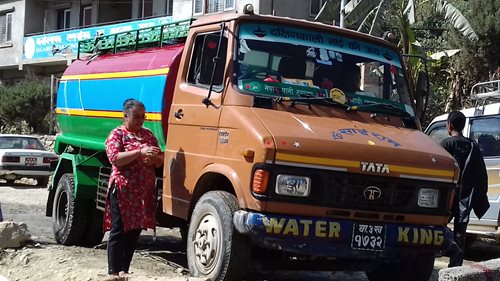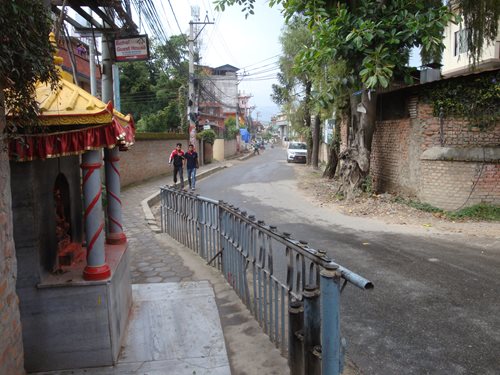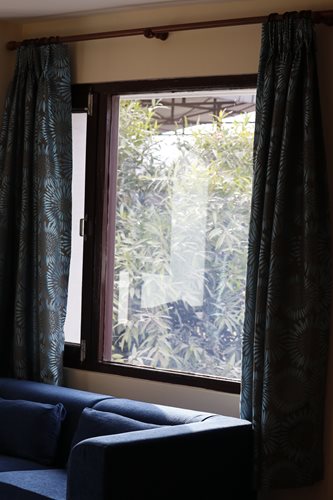I don’t have any home help in the UK. Having been brought up by somewhat Puritanical parents with a strong work ethic, employing domestic assistance here in Nepal seems decadent, almost dastardly. The thing is that nothing’s a given here. Everything is a little more complex and labour-intensive. Take water for example. The flat we’ve rented has a relatively good water supply – which means that a trickle of water dribbles into our tank for perhaps an hour once or twice a week. We are careful not to waste water but even so this isn’t enough so we supplement the public supply by buying tankersful brought from springs at the Valley edges. It is a matter of phoning a number and the tanker arrives and we pay the driver Rp 1800/- (£13). That's assuming we've been able to find an ATM that will let us have some cash.
I managed to get through to the right number yesterday, after trying for a couple of days and yes they would come between six and seven o’clock.
I wanted to be sure of the timing. ‘That is this evening?’
‘Huzoor.’
‘Today?’
‘Today only.’
I waited and at 8pm accepted that they weren’t coming. Firm arrangements are never that solid here so what did I expect? Probably the water man hadn’t wanted to disappoint while we were speaking on the phone.
Then at 6.30 this morning I heard a truck arriving. They had brought our water. It was – after all – between 6 and 7o’clock.
 |
| Tankers bring drinking water to homes all over the Kathmandu Valley |
The flat we are renting had been gutted before we moved in and was completely bare. We undertook to furnish it ourselves. That reduced our rent and ensured we’d have a home free from tassels, fluted furniture and garish colours. As the unemployed spouse (I shudder to consider myself a housewife), it fell to me to find suitable curtain material for our many windows. I was relieved to discover that furnishing shops have their own tailors as I’d imagined having to measure up, find the cloth then take it on my bicycle or in a taxi to a tailor. No, all I had to do was specify the cloth, give window dimensions and come back two days later. It sounded wonderfully easy.
Except that two days proved to be a rather elastic time frame. At the first furnishers, the curtains weren’t ready after two days, or four days, or five days. But it was the holiday season so what could I expect? I picked up the finished curtains a week later. They were nicely made, if rather expensive.
I thought I’d try a second shop for the next set of curtains. This was recommended by our landlord, a chap who knows a bargain when he sees one, although he did mention that they’d promised to deliver his curtains before the Dasain holidays and hadn’t.
I went to see them. They were closed. But it was the holiday season so what did I expect? I pedalled by the shop several times over the next ten days or so but the shutters were always down.
Finally, after Tihar, the shop was open and fabric prices were reasonable. I chose my cloth, gave the measurements, explained I wanted Rings and no dangly extras, no frills. They said they’d be ready in a week and they’d phone when the curtains were ready. They didn’t phone. The curtains weren’t ready after ten, twelve or fourteen days. One of the challenges of living in Nepal is that Nepalis don’t want to disappoint people. If I ask if something will be ready the next day, they’ll agree just so as not to disappoint, seemingly not considering that a failed promise is more disappointing. I can’t remember how many times I went into this particular shop but it got so that I just had to appear at the door and they’d be on the phone to their ‘factory’ to get a new estimate of when the foreigners blue curtains would be ready. Finally, I went to pick up my prize. I pedalled home to discover that there were no curtain rings. Normally rings are fitted so that they can be slipped onto the rail in less time than it takes to find a chair to climb up on.
I returned to the shop. I collected rings and curtain hooks, came back home, fitted them and put the curtains up. They’d been made with cloth that was twice the width of the window, but despite this were far too small. The tailor had stitched six over-generous pleats in each curtain so that only three-quarters of the window was covered. Each curtain was about 70cm. wide. I unpicked one pleat and next day returned to the shop to explain that each curtain need to be a metre wide. I asked them to restitch the pleats – suggesting only five were needed. They told me that this small piece of work would take two days.
Three days later (I thought I’d allow for local scheduling difficulties) they suggested that my curtains would be ready the following day – which of course they weren’t. By this time even my husband’s colleagues knew that curtains were becoming my only topic of conversation. I was seriously losing patience with the shop but to their credit they said they’d deliver the curtains the following evening.
The next challenge is that there are no real addresses or many street names in the Siamese twin cities of Kathmandu and Patan, and outsiders like me notice different landmarks to those important to locals. In addition, I’m not that good at giving directions – or at least my grasp of Nepali isn’t good enough to give clear directions face to face, let alone on a mobile with poor reception. I thought they’d understood that we were a stone’s throw from a crossroads where taxis often wait. It was close to a popular Ganesh shrine.
My phone rang. It was dark. Unknown number. The curtain shop. They hung up on hearing my stuttering voice. They called again. A different man’s voice. ‘We are here at the crossroads.’
‘I’m coming,’ I said. ‘What kind of car are you in?’
‘We’re on a motorbike.’
I went out into the night. At 7pm the roads are packed with men on motorbikes. Several were waiting at the crossroads nearest our apartment. I was the only foreigner. None took any notice of me. None looked to be carrying curtains.
I called the curtain-man. ‘Where are you?’
‘At the crossroads.’
‘Which crossroads?’
‘The one with the Ganesh shrine.’
The nearest Ganesh shrine isn’t on a cross-roads but at a T-junction where a muddy lane meets a tarmacked road.
(Note to self – can chowk mean T-junction as well as crossroads? I need to ask my Nepali teacher.)
‘You are at the Ganesh shrine?’
‘Huzoor.’
‘I’m coming.’
Several men were waiting on the road but as I approached the Ganeshtan I spotted a chap with a big bag that had to contain the curtains. He made the drop.
I scuttled back home to discover the curtains now had five pleats but were still only 70cm wide.
At which point Nepalis might say, ‘What to do?’
 |
| The little Ganesh shrine in Bakhundole, Patan |
 |
| Well-nourished Ganesh, god of literature and fun, is a popular deity |
 |
| P.S. The rereremade curtains arrived three days later |